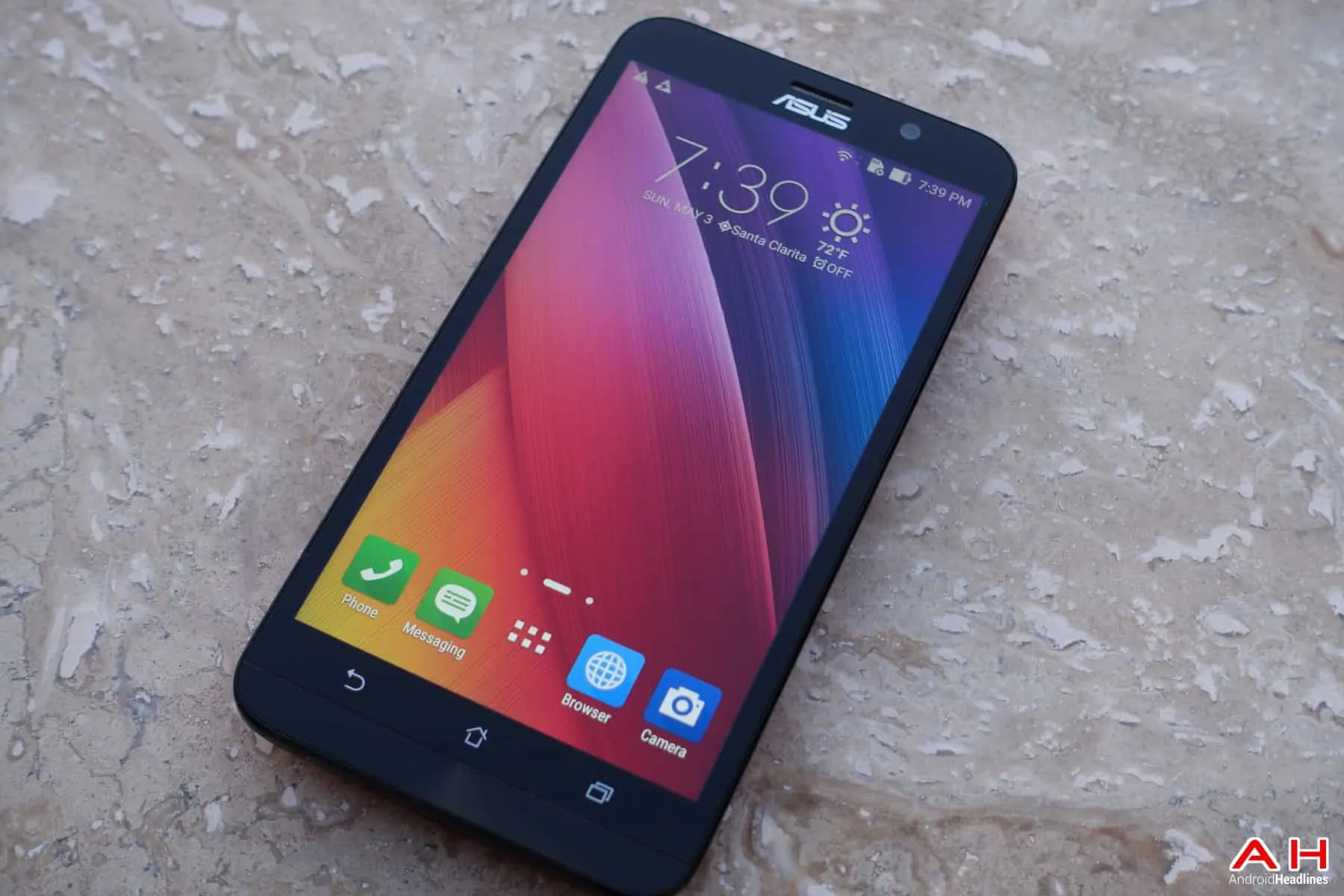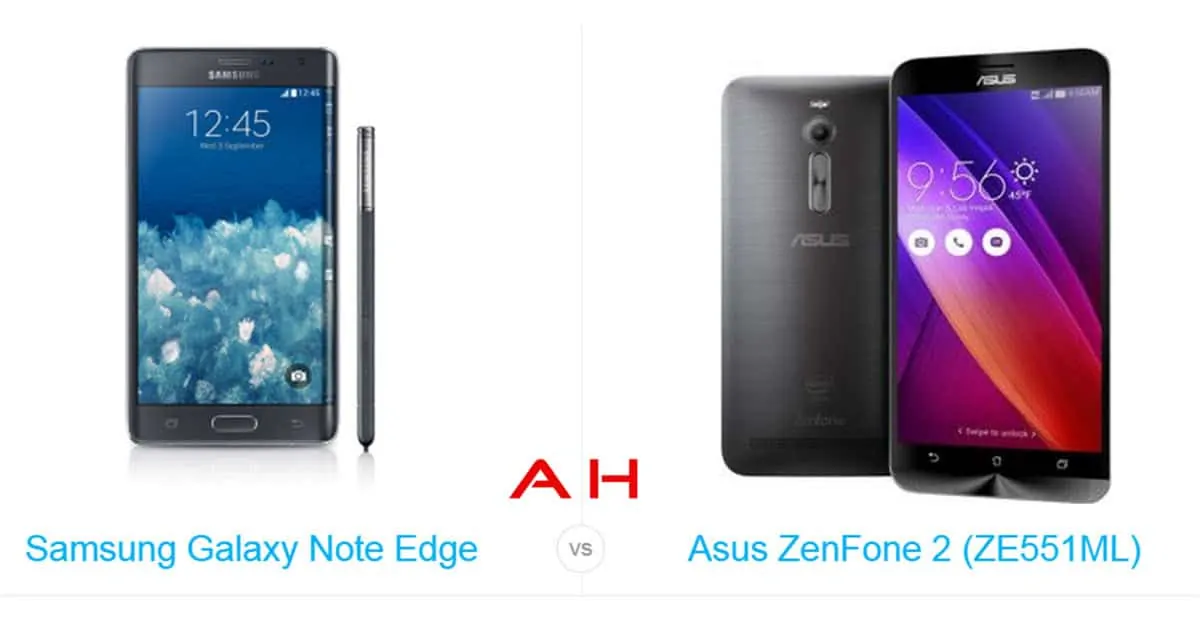Introduction
Boy do we have a good one for you today – the powerful and innovative Samsung Galaxy Note Edge goes up against the new ASUS ZenFone 2…the one with 4GB of RAM and 64GB of internal memory. I can hear you now saying that I will pick the Galaxy Note Edge over the new Chinese phone, but I know right now that this is going to be a real tough decision, especially because of the prices. On one hand, we have this fantastic Galaxy Note Edge with an innovative curved, QHD display, an S-Pen and a price tag of $800 off-contract and even $400 on a two-year contract. On the other hand, we have the ZenFone with a 64-bit Intel Atom processor, 4GB of RAM, 64GB of internal storage all for the price of $300 off-contract…less than the two-year price of the Note Edge.
Despite their huge difference in price, these two devices do have a few things in common. For starters, they are very close in physical size with the Note Edge slightly wider, thinner and only 4 grams heavier than the ZenFone 2. The displays are almost the same size – the Galaxy Note Edge is 5.6-inches and the ZenFone 2 is 5.5-inches – although they are different technologies and different resolutions. They both use a quad-core processor, although the Note Edge is only a 32-bit while the newer ZenFone 2 has 64-bit technology. They also share the usual suspects – Wi-Fi, Bluetooth 4.1 on the Note Edge and the 4.0 on the ZenFone 2, GPS, NFC and a microUSB port for charging and data transfer. They both use a 3000mAh battery – removable in the Galaxy Note Edge and non-removable in the ZenFone 2 and both offer a quick charge feature to charge the battery at a faster rate.
Please take a deliberate look at the detailed Specifications Comparison chart below and here you will see just how these two great devices stack up against one another – click on the “View Full Comparison” link at the end of the chart to expand the details. After that, we will look at each individual device in greater detail and point out some of its pros and cons. From all of this information we will try to determine the winner based on specs and execution of design and functions.
Specifications
Samsung Galaxy Note Edge
 The Samsung Galaxy Note series has a very loyal following – now they added a Galaxy Note Edge into the mix with a cool looking curve on one ‘edge’ of the display. Samsung improved the Galaxy Note in every department – from the display, the build quality, to the processor, the camera and even the S-Pen. The improved metal frame, trim and back panel, give it even a more premium look device with a build quality that feels great in your hand.
The Samsung Galaxy Note series has a very loyal following – now they added a Galaxy Note Edge into the mix with a cool looking curve on one ‘edge’ of the display. Samsung improved the Galaxy Note in every department – from the display, the build quality, to the processor, the camera and even the S-Pen. The improved metal frame, trim and back panel, give it even a more premium look device with a build quality that feels great in your hand.
The Samsung Galaxy Note Edge’s display is a 5.6-inch Super AMOLED beauty with a QHD resolution of 2560 x 1440 pixels, a curve on its right-hand side and 524 pixels-per-inch (PPI), whereas the ZenFone 2 is still using last year’s FHD LCD display with 403 PPI. The Galaxy Note Edge uses the excellent, but only 32-bit, Qualcomm Snapdragon 805 quad-core processor clocked at 2.7GHz (US market). The ZenFone 2 is using the newest 64-bit Intel Atom Z3580 quad-core processor clocked at 2.3GHz. The Note Edge packs 3GB of RAM and 32GB of internal storage with a microSD card slot for additional expansion of 128GB, while the ZenFone 2 has 4GB of RAM and a base 64GB of internal memory, also with a microSD slot for an additional 64GB of memory.
As they do every year, Samsung improved the camera with a 16MP sensor, Autofocus, LED Flash, ISOCELL technology, and then added in OIS+ and Live HDR shooting. The ZenFone 2 has a slightly smaller 13MP main camera with Autofocus, Dual-Tone LED flash and no OIS. The front-facing camera (FFC) on the Note Edge is a wide-angle 3.7MP sensor and lens for excellent group selfies and conference style video chats while the ZenFone 2 has an even larger 5MP FFC. The removable 3000mAh battery is the same as the 3000mAh non-removable battery on the ZenFone 2, but both should last you all day. If you should you need to extend that time, you can use Samsung’s Ultra Power Saving Mode (UPSM) or its Quick Charge 2.0 feature….the ZenFone 2 also has a fast charge option.
As far as additional features that the Galaxy Note Edge possesses over the ZenFone 2 -it has three microphones for improved calling and noise reduction. It comes with Download Booster, a Fingerprint Scanner (PayPal certified), Heart Rate Sensor, UV and Oxygen Saturation Sensor. Samsung greatly improved the S-Pen by increasing its sensitivity by two, upgraded its software and the functionality that it adds to the Note series. It is now updated to 5.0 Lollipop and will cost you $400 on a two-year contract or about $800 off-contract.
ASUS ZenFone 2 (ZE551ML)

The ASUS ZenFone 2 stole a few tricks from the LG by using a plastic body with a brushed metallic-like finish. It does not feel cheap, but it is nowhere near the look and feel of the Galaxy Note Edge’s all-metal frame and faux leather back. The ZenFone 2 also stole the placement of rocker switch for the volume control on the back of the device, however, the on/off button is on the top of the device. The nicely rounded sides make the ZenFone 2 easy to hold and also helps to explain its 10.9mm thickness.
The ASUS ZenFone 2 sports a 5.5-inch IPS LCD FHD display with a resolution of 1920 x 1080 pixels and 403 PPI…a very good display, but it just cannot touch the 524 PPI on the QHD display of the Galaxy Note Edge. We are looking at ASUS’s top-of-the-line ZenFone 2 model with the 64-bit Intel Atom Z3580 quad-core processor clocked at 2.3GHz, coupled to 4GB of RAM and 64GB of internal memory as well as expansion by way of a microSD card. This compares to the Galaxy Note Edge’s older 32-bit Qualcomm Snapdragon 805 quad-core processor, 3GB of RAM and 32GB of onboard storage along with room for 128GB of expansion.
ASUS put decent cameras in the ZenFone 2 with the main camera using a 13MP sensor with autofocus and a dual-tone LED flash, but no OIS. This will certainly supply some decent photos, however it just cannot stand up to the 16MP camera and features on the Galaxy Note Edge. The ZenFone 2 comes with a larger 5MP FFC for social selfies and video chatting – the Note Edge uses a 3.7MP with a wide-angled lens for wider shots. Even though the back easily comes off the ZenFone 2, it uses a non-removable 3000mAh battery, the same size as Galaxy Note Edge’s removable battery.
This Dual-SIM ZenFone 2 is running Android 5.0 Lollipop along with its ZenUI Skin overlay and sports a FM radio not found in the Note Edge. You can also find the ASUS ZenFone 2 (ZE551ML) with 4GB of RAM and 64GB of memory on Amazon for only $299 and comes in black, silver, gold, or red.
…And The Winner Is…

Summary
Oh this was an agonizing decision – the Galaxy Note Edge would be my personal choice, however, you cannot discount two things…one, the price, and secondly, that most people would not use many of the features on the Note Edge, such as the S-Pen. For the everyday smartphone user that makes phone calls, texts, emails, snaps a few pictures, takes a few selfies, plays a few games, watches a few videos and likes to save money…I am picking the ASUS ZenFone 2 as the winner of this comparison.
This dual-SIM smartphone has a FHD display (same as the HTC One M9 and Xperia Z3+), a newer 64-bit Intel Atom quad-core processor, 4GB of RAM and 64GB of internal storage as well as room for expansion. It has a good main camera and a large 5MP FFC – it will not take pictures as good as pictures taken on the Galaxy Note Edge, but it will satisfy most users that take pictures to share or show on their smartphone. It has an FM Radio, fast battery charging, a large 3000mAh battery and can be purchased for only $300 off-contract.
The Galaxy Note Edge does have a beautiful display and oh that curved edge is so ‘sexy’ looking and actually quite practical. It also has the infamous S-Pen and associated software that make the Note series so unique…but would you really use it? It also has a fingerprint scanner, a better main camera and features, an IR Blaster, a heart rate sensor, UV and oxygen saturation sensor. The 3000mAh battery (same size as the ZenFone 2) is removable and it has the Quick Charge 2.0 availability. You will have to make the decision whether or not those extra features are worth an extra $500 dollars…most would say not, so that is why the ASUS ZenFone 2 is the winner on this comparison.

